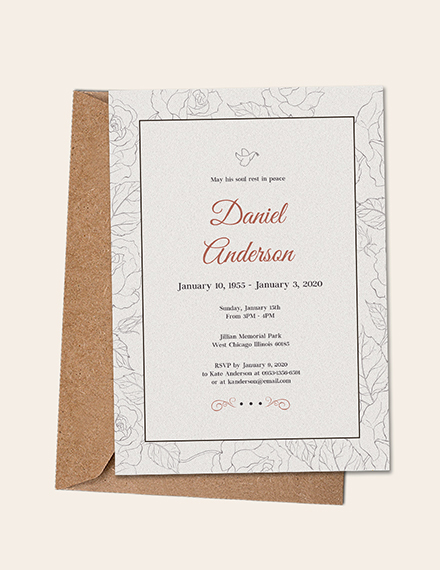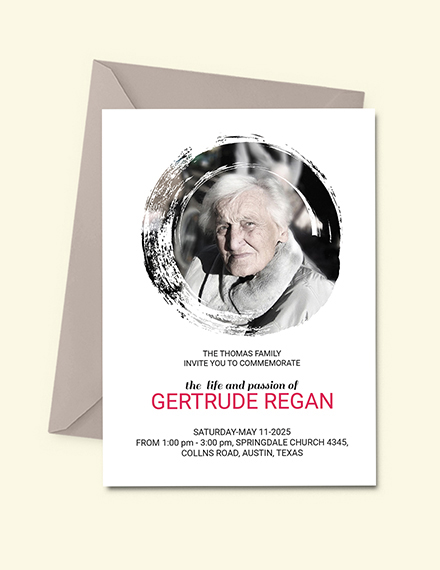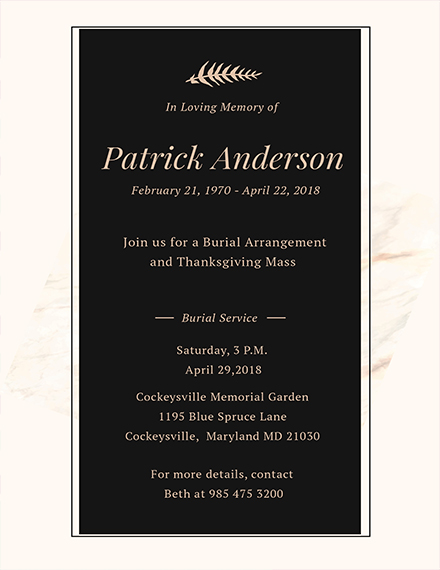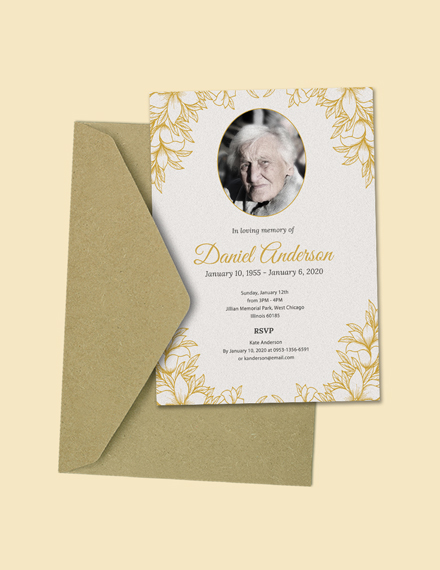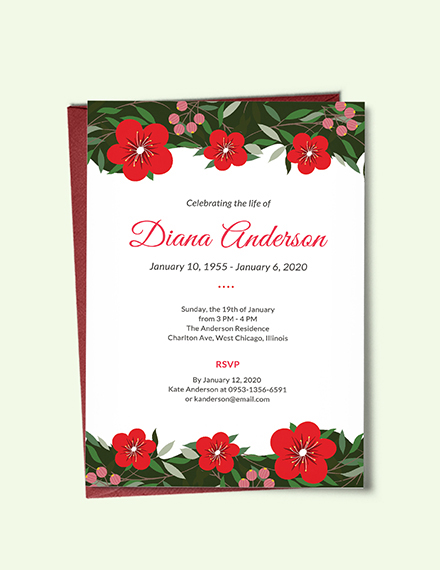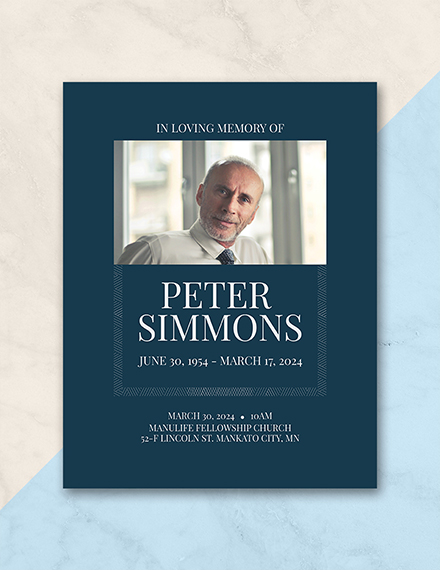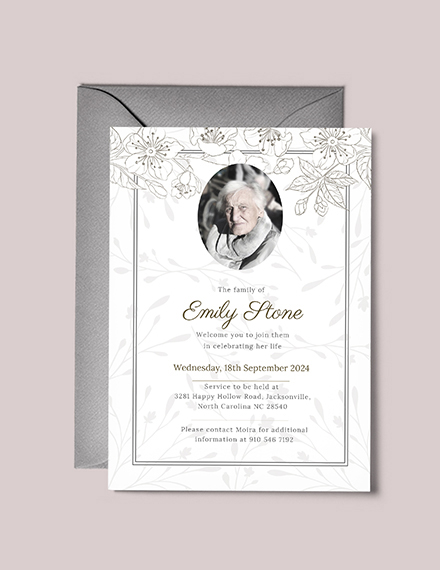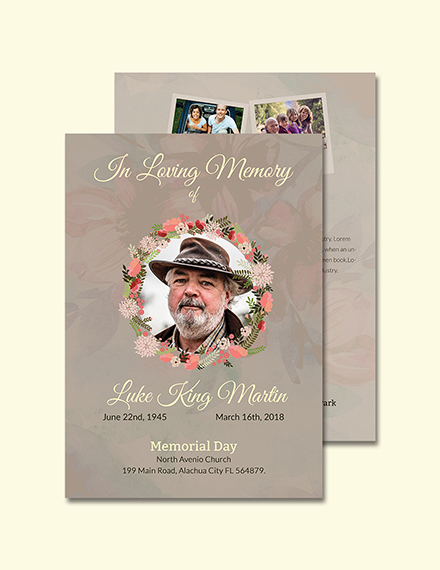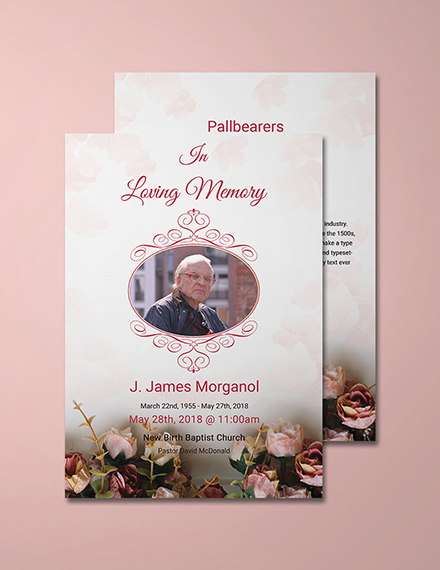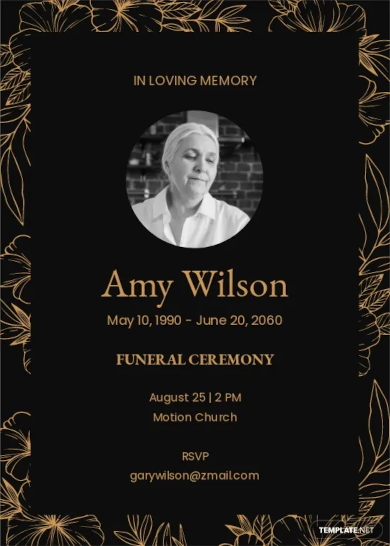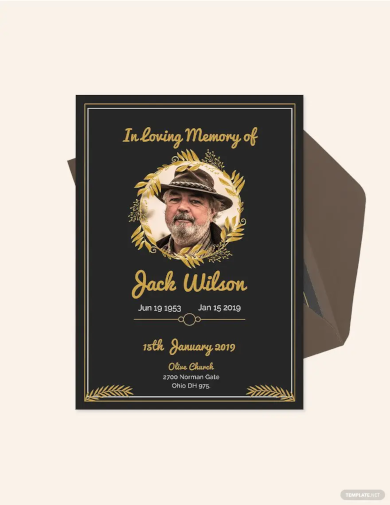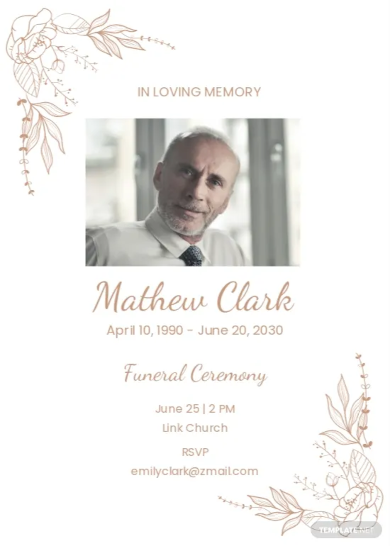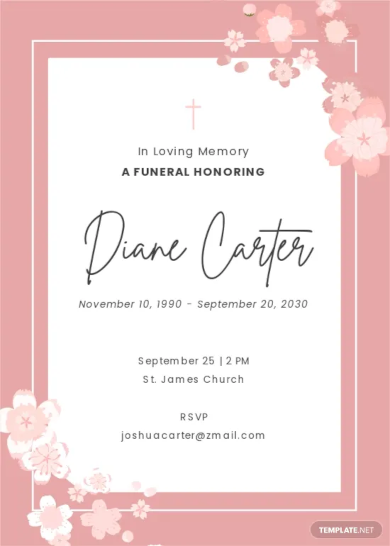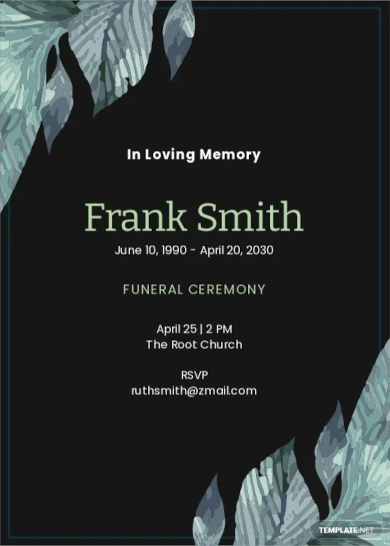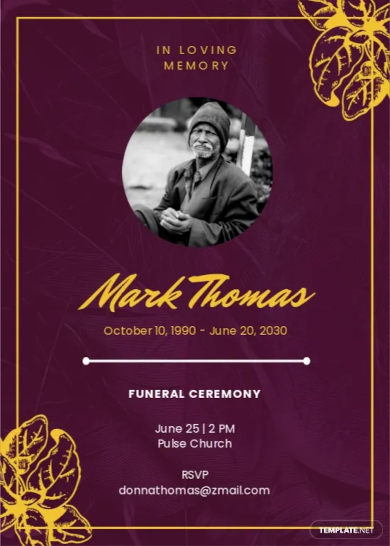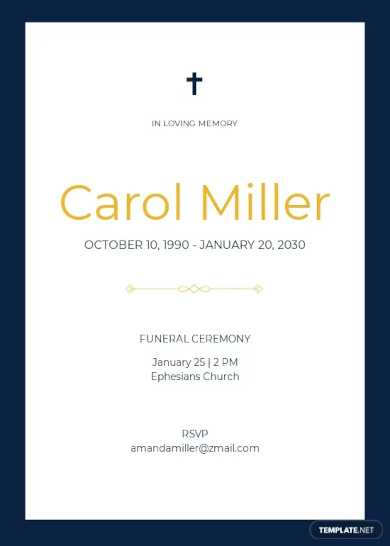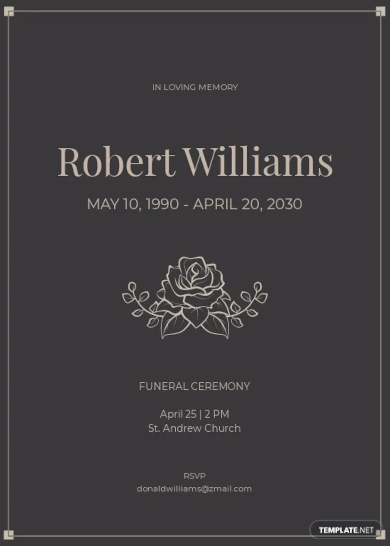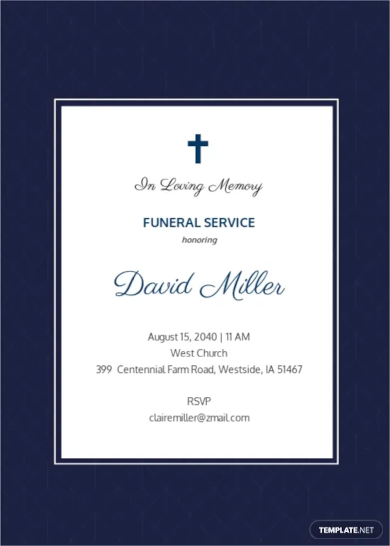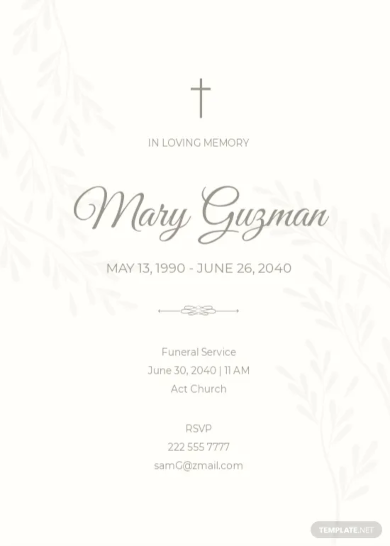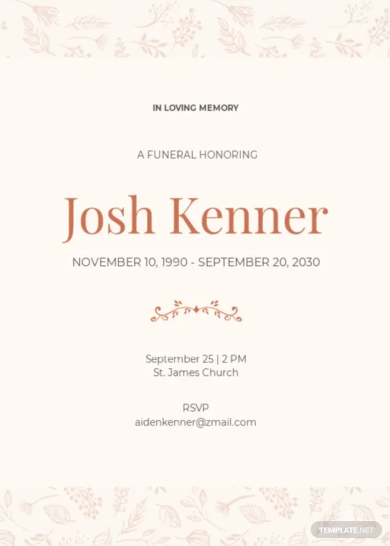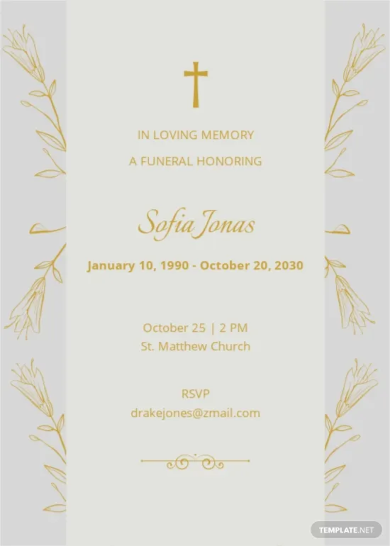30+ Funeral Invitation Examples to Download
There is no best way to invite people to a funeral or memorial service. It all depends on what works for you and your situation. But once the funeral or memorial service has been scheduled, you’ll want to invite people to the service and let them know when and where it will be held.
For this, you will need a proper invitation. Check out below for more information.
Elements of a Good Funeral Invitation
There are a few elements that separate a good funeral invitation from every other straw in the haystack:
1. An appropriate color palette: Choosing the appropriate color for your invitation can be tricky. Of course, we want to choose a cute color, one that the deceased would have liked. But we also want to observe the somber occasion, and these two things can be quite contradictory. Light colors are perfectly acceptable. You don’t need to have an all-black motif just because it’s a funeral. You can even go with a happy blue or a girly pink, as long as the color you choose will help you create your desired atmosphere for the service.
2. Visual elements: A few graphic decorations here and there couldn’t hurt. Just because we’re in mourning doesn’t mean we have to look boring. Besides, the deceased would love a few pretty things on the invitation. Floral is a staple design on an invitation. The ocean or the sky in the background is a pretty good choice too. You can also attach a photo of the deceased on the front of the invitation.
3. Headline: The recipients of your invitation should know what it is for at first glance. You can’t have them expecting a birthday celebration only to find out that, in truth, a dear, loved one passed away. Some effective funeral wording is necessary for your invitation.
The deceased’s full name on the center of the page is the standard, but you can always personalize it. Here are a few examples:
- “The Life of Jane”
- “Remembering Laura”
- “Let’s celebrate life in loving memory of Olivia”
- “Thank you, Eleanor.”
- “Celebrate John’s Life”
- “Remembering our beloved friend, Annie”
- “Please join us as we remember and celebrate the life of Amy.”
4. Accurate Information: Your funeral invitation’s main purpose is to communicate to people the important details of the funeral service for the deceased. Before you print them on the invitation, make sure that they are final and that the whole family agrees with it all.
10+ Funeral Invitation Templates
Simple Funeral Invitation Template
Funeral Invitation Template
Funeral Service Invitation Template
Funeral Ceremony Invitation
Funeral Repast Invitation Template
Funeral Program Template
Funeral Announcement Invitation
Funeral Invitation Template
Catholic Funeral Program Invitation
Catholic Funeral Invitation Template
Funeral Invitation Card design Template
Funeral Invitation Card Template
Elegant Funeral Invitation Card Template
Floral Funeral Invitation Card Template
Digital Funeral Invitation Template
Modern Funeral Invitation Card Template
Personal Funeral Invitation Card Template
Simple Funeral Invitation Card Template
Sample Funeral Invitation Card Template
Communication Funeral Invitation Card Template
Communication Funeral Invitation Template
Blank Funeral Invitation Card Template
Email Funeral Invitation Template
Modern Digital Funeral Invitation Template
Elegant Digital Funeral Invitation Template
4+ Funeral Invitation Examples
Stephen Hawking Funeral Invitation

Watercolor Funeral Invitation
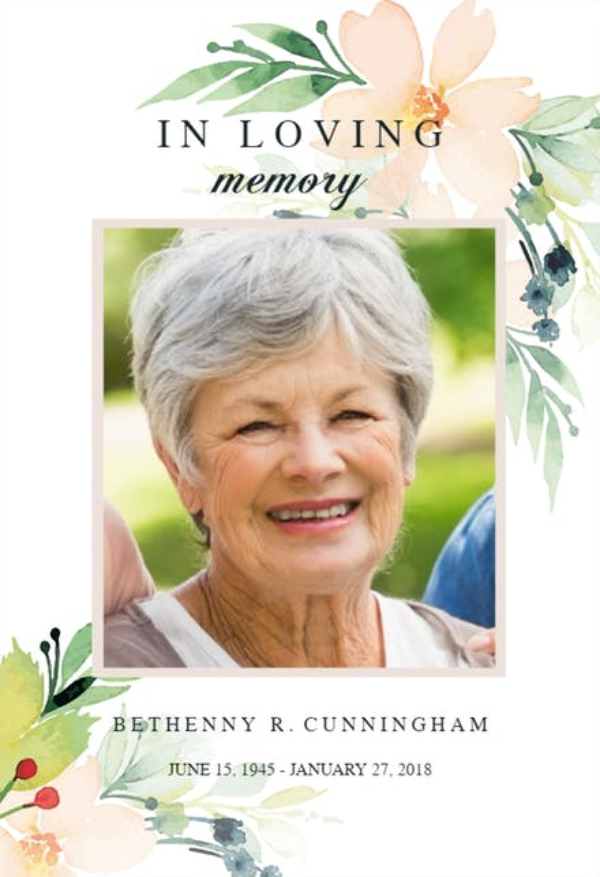
Funeral Invitation Example
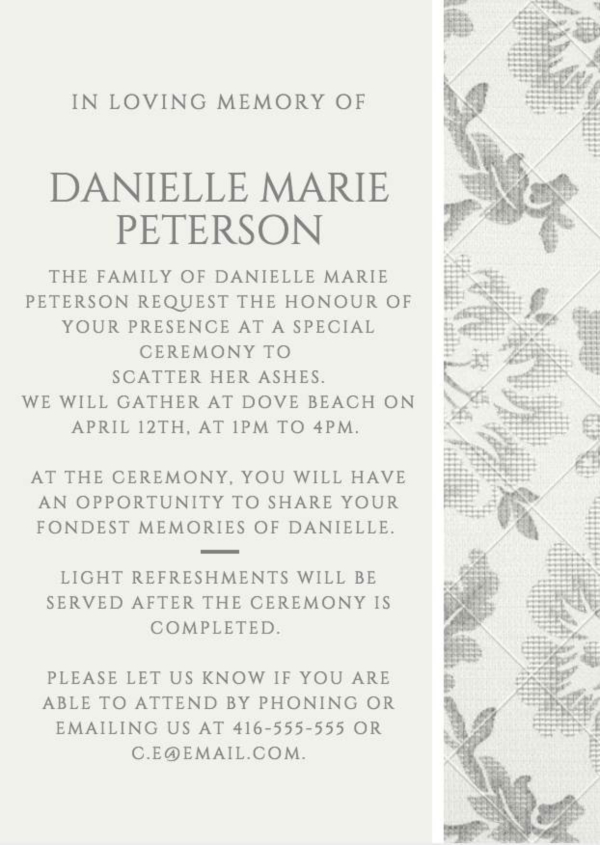
Simple Funeral Invitation
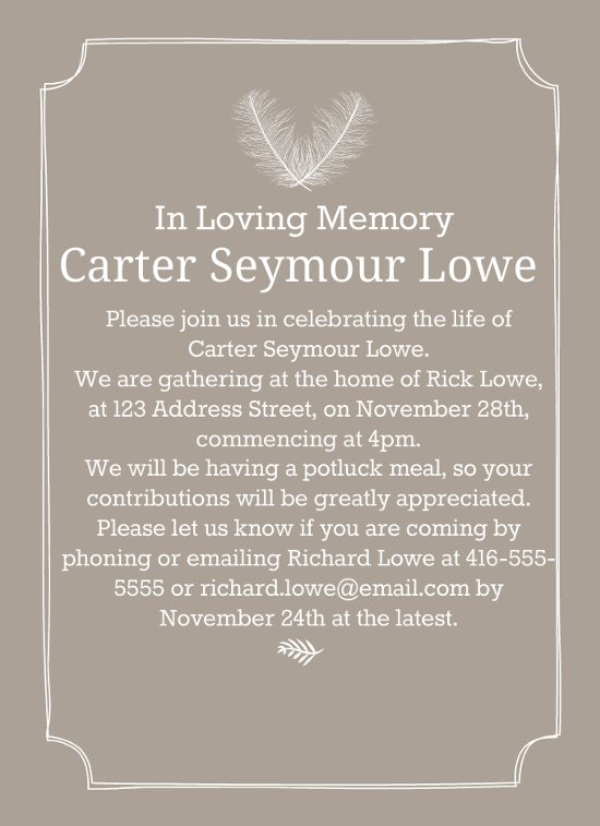
Sample Funeral Invitation Template
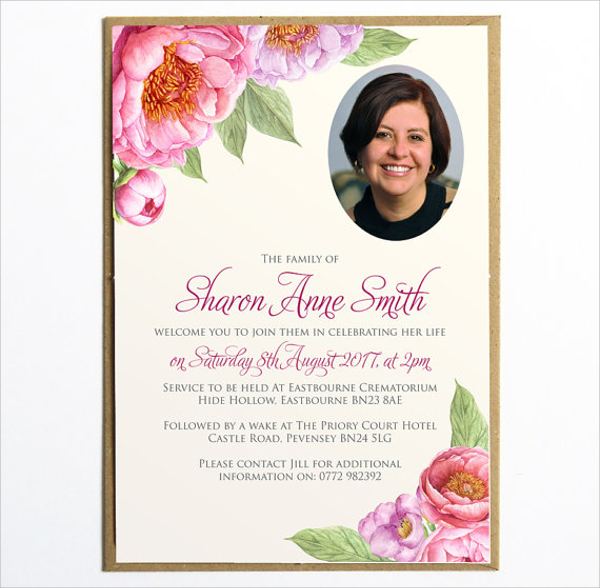
Simple Tips for an Excellent Funeral Invitation Layout
You can refer to this list when deciding on what information goes on the funeral invitation.
1. Name of the deceased: You should, of course, include the person’s full name and any associated titles. A nickname directly associated with the deceased may also be used to help stir familiarity in friends and family members. If the person is female and was married, it is a good idea to include her maiden name as well, to help people remember.
2. Residence of the deceased: It is also a good idea to include where the person lived.
3. Surviving family: Include all members of the surviving family, spouse, children, siblings, grandchildren, great-grandchildren, if any. This will help if someone who is acquainted only with a member of the surviving family reads the notice. At least they can pay their respects to their friend who just lost a loved one.
4. Funeral date, time, and place: Since you are already making an invitation, it is assumed that the details of the funeral have already been set in stone. Your invitation should communicate all these information to the recipients.
5. Clergy for the funeral: Include this information if available.
6. Memorial or floral contribution: Let people know whether or not floral contributions will be accepted or you want donations to be sent to a chosen charity.
7. Photo: It is always nice to include a happy picture of the deceased.
8. Private or public funeral: Let people know if you are planning on having a private family-only funeral or it will be open to the public.
When someone dies, it can be important to ensure that everyone who knew and loved them has the opportunity to pay their respects at the funeral. Funeral invitations often serve two purposes: to inform people of the funeral venue and to confirm the sad news about someone’s death. Here are a few examples of funeral invitation wording:
- We wanted to let you know the sad news that Joe died peacefully in Thattown Hospital on November 21. Many thanks to all of you for your kind thoughts, visits, and messages that were such a comfort to him in his final hours.
- In loving memory of Joe Smith, who sadly passed away on November 21, 2018, after a short illness. Loving husband to Mary, dad to Megan, and much-loved grandad and brother.
A funeral invitation may also include:
- “In loving memory of…”
- “Celebrating the life of…”
- “R.I.P.”
- A floral motif, a religious symbol, or a design that reflects the lifestyle or hobby of the deceased
- Contact details for RSVPs or queries
- Special family requests or thanks for flowers, donations, and any other acts of kindness
- A line from a poem or a favorite quote
How to Create a Funeral Invitation
You can use funeral invitation templates to create memorial cards, bookmarks, and prayer cards. Using a template can simplify the process of creating your own design and layout. Templates come in a variety of applications including Microsoft Word and Publisher. In fact, there are several amazing examples posted in this article for you to choose from.
Types of Invitations
Different types of invitations can be used for all sorts of events. When deciding on an invitation, consider the nature of the event and the potential impact of the invitations on your budget. There are two recognized types of invitations available today:
1. Handwritten: Handwritten invitations are usually sufficient for small, intimate affairs where the guest list us under 50. Examples of this include luncheons, private receptions, and small dinner parties. Handwritten invitations take extra time and commitment, so they are not best suited for larger parties.
Handwrite invitations on pretty pieces of stationery or plain white paper. Choose a quote from a famous author or make up your own slogan to add as an introduction to the invite. Handwritten invitations make up for a more personal touch, so feel free to add an individual note for each invited guest.
2. Electronic Invitations: Today, we send almost everything electronically. The same can be true for invitations. Electronic invitations save resources such as paper and stamps and provide a quick way to get a message across. These are especially helpful if you are planning an event that is last minute and you do not have time to mail the invitations.
Many online sites offer electronic invitations and once you choose one, you can enter in several of your contacts at the same time. Once you hit send, everyone on the list receives your invitation. Some sites even let you know when your invitation has been read so you can be sure that it has reached the guest.
Invitation Sizes
Find the right envelope size for your invitation:
- A1 Envelopes: The most popular size for response envelopes, A1 (3 5/8 × 5 1/8 envelopes accommodate A1 (3 1/2 × 4 7/8 cards). They’re also great for note and thank-you cards.
- A2 Envelopes: A2 (4 3/8 × 5 3/4) envelopes are made for (4 1/4 × 5 1/2) or quarter fold cards, the perfect size for reply cards, note cards, greeting cards, stationery, and more.
- A6 Envelopes: Not too big, not too small, A6 (4 3/4 × 6 1/2 inch) envelopes are perfect for housing 4×6 photos, cards, invitations, save the dates, and more.
- A7 Envelopes: One of the most popular invitation envelope sizes, A7 (5 1/4 × 7 1/4) envelopes fit standard 5×7 cards and come in a huge variety of colors, finishes, and styles.
- A7.5 Envelopes: Slightly larger than a standard A7, A7.5 envelopes measure 5 1/2 × 7 1/2 inches. Use as a standalone outer invitation envelope or couple with its corresponding A7 for a contemporary double envelope option.
- A8 Envelopes: A8 envelopes measure 5 1/2 × 8 1/8 and accommodate 5 3/8 × 7 2/4 (A8) cards. Choose from several finishes and use for invites and stationery designs of all sorts.
- A9 Envelopes: The envelope size you need for those half fold cards, A9 envelopes measure 5 3/4 × 8 3/4 and are made for 5 1/2 × 8 1/2 (A9) cards, invitations, and correspondence.
- A10 Envelopes: Measuring 6 × 9 1/2 inches, A10 invitation envelopes are large, distinguished, and sure to stand out in a mailbox.
Funeral Invitation FAQs
What is the difference between a funeral and a memorial?
A funeral service is a service held to memorialize a deceased person with their body present. A memorial service held to memorialize a deceased person with their body not present.
How long do you wait before a funeral?
Some families opt to hold the funeral and burial as soon as 24 hours after their loved one’s passing. For other, the time between death and the funeral service is around 2–3 days.
What’s the difference between a visitation and a funeral?
When you attend a funeral, you’ll be involved more in the act of burying the deceased. You often have a visitation, viewing, or wake that enables the family and close friends to have some closure and pay their last respects.
The death of a loved one is never easy, but the presence of people who can share the pain with you will help you accept the situation easier. Let funeral invitations be your subtle way of letting people know that you need them during this trying time. And, of course, to let them see their beloved for the last time.



